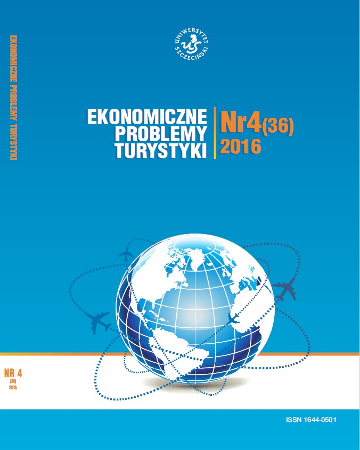
ISSN: 1644-0501
eISSN: 2353-3188
OAI
DOI: 10.18276/ept.2019.1.45-01



Issue archive /
nr 1 (45) 2019
Assessment of applicability of forecasting methods of passenger traffic by air as a key factor in tourism development in Poland
| Authors: |
Kamila
Bednarz-Okrzyńska
University of Szczecin |
| Keywords: | tourism airports passenger traffic forecast seasonality |
| Data publikacji całości: | 2019-09-10 |
| Page range: | 10 (7-16) |
| Klasyfikacja JEL: | C01 C22 C53 |
Abstract
The author of the paper focuses on the key factor in tourism development which is air passenger transport. It considers the forecast for five airports which in the first half year attended to the largest number of passengers as well the overall passenger traffic in Poland. The forecast was made for the first two quarters of 2018 on the basis of the quarterly data from the period of 2011-2018. The method applied in the paper consisted in making calculations for varying number L of recent years taken into account in the model. The model of additive and multiplicative seasonality was considered. The research problem was formulated as the question whether the smallest value of residual standard deviation corresponds to the smallest value of error MAPE (Mean Absolute Percentage Error). By applying the method of trends of univariate periods the following were determined: residual standard deviation, relative error ex ante VA and forecast error MAPE. The purpose was to answer the question whether the minimum value of MAPE corresponds to the minimum value of standard deviation S, or to the smallest value of error ex ante. In the case of the linear trend, a simplified method of “three points” was proposed, whereas for the parabolic trend, a method of “four points” was proposed. It was found that the method of trends of univariate periods yields the forecast error ex post comparable to the one of classic methods of seasonality analysis (including the Klein method).
Download file
Article file
Bibliography
| 1. | Briggs, D. (2004). Tourism development and airlines in the New Millennium: an operations management perspective. In: L. Lumsdon & S. J. Page (eds.), Tourism and transport: issues and agenda for the New Millennium (pp. 117-131). Amsterdam-San Diego-Oxford-London: Elsevier. |
| 2. | Chung, J. Y., Whang, T. (2011). The impact of low-cost carriers on Korean Island tourism. Journal ofTransport Geography, 6 (19), 1335-1340. |
| 3. | Cieślak, M. (ed.) (2001). Prognozowanie gospodarcze. Metody i zastosowanie. Warsaw: Wydawnictwo Naukowe PWN. Gierałtowska, U. (2000). Metoda trendów jednoimiennych okresów a prognozowanie brakujących danych. Wiadomości Statystyczne, 9, 3-12. |
| 4. | Kowalczyk, A. (2013). Relacje zachodzące między rozwojem transportu lotniczego a rozwojem turystyki. In: R. Pawlusiński (ed.), Współczesne uwarunkowania i problemy rozwoju turystyki (pp. 61-72). Cracow: IGiGP UJ. |
| 5. | Maciąg, K., Stępniak, C. (2008). Uproszczone wzory na estymację trendu i efektów sezonowych. Przegląd Statystyczny, |
| 6. | 2 (55), 38-47. |
| 7. | Milewski, D. (2010a). Rola transportu w kształtowaniu atrakcyjności turystycznej regionu. Zeszyty Naukowe Uniwersytetu Szczecińskiego, 582, Ekonomiczne Problemy Usług, 48, 219-230. |
| 8. | Milewski, D. (2010b). Transport lotniczy w obsłudze ruchu turystycznego - analiza zależności i prognoza zmian na przykładzie województwa zachodniopomorskiego. In: M. Michałowska (ed.), Efektywność transportu w teorii i w praktyce (pp. 117-128). Katowice: Wydawnictwo Akademii Ekonomicznej. |
| 9. | Stańko, S. (2013). Prognozowanie w agrobiznesie. Teoria i przykłady zastosowania. Warsaw: Wydawnictwo SGGW. Tłoczyński, D. (2009). Wpływ polityki otwartego nieba na funkcjonowanie regionalnych portów lotniczych w Polsce. In: B. Liberadzki (ed.), Liberalizacja i deregulacja transportu w UE. Oczekiwania i doświadczenia (pp. 247-261). Warsaw-Poznań: ILiM. |
| 10. | Turton, B. (2004). Airlines and Tourism Development: the Case of Zimbabwe. In: L. Lumsdon, S.J. Page (eds.), Tourism and Transport: Issues and Agenda for the New Millennium (pp. 69-78). Amsterdam-San Diego-Oxford-London: Elsevier. |
| 11. | UNWTO (2018). Tourism highlights 2018 Edition. Retrieved from: https://www.e-unwto.org/doi/pdf/10.18111/ 9789284419876 (15.12.2018). |
| 12. | Urząd Lotnictwa Cywilnego (2018). Statystyki i analizy rynku transportu lotniczego. Retrieved from: http://www.ulc. gov.pl/pl/regulacja-rynku/statystyki-i-analizy-rynku-transportu-lotniczego/3724-statystyki-wg-portow-lotniczych (26.10.2018). |
| 13. | Wheatcroft, S. (1998). The Airline Industry and Tourism. In: D. Ioannides, K.G. Debbage (eds.), The Economic Geography of the Tourist Industry. A Supply-side Analysis (pp. 159-179). London-New York: Routledge. |
| 14. | Zeliaś, A., Pawełek, B., Wanat S. (2003). Prognozowanie ekonomiczne. Teoria, przykłady, zadania. Warsaw: Wydawnictwo Naukowe PWN. |
| 15. | Zieliński, Z. (2002). Analiza ekonomicznych procesów stochastycznych. Pisma wybrane. Toruń: Wydawnictwo Naukowe Uniwersytetu Mikołaja Kopernika. |